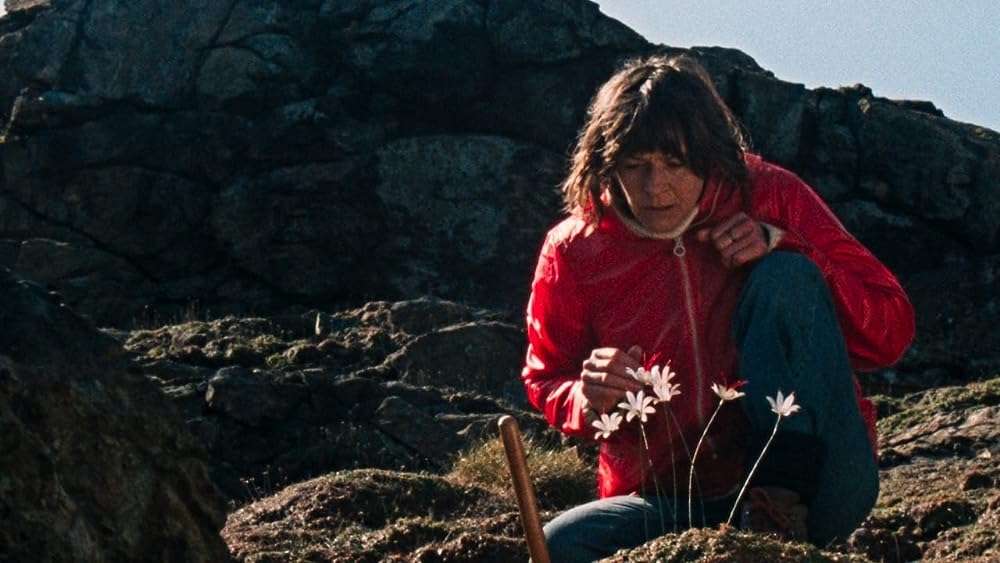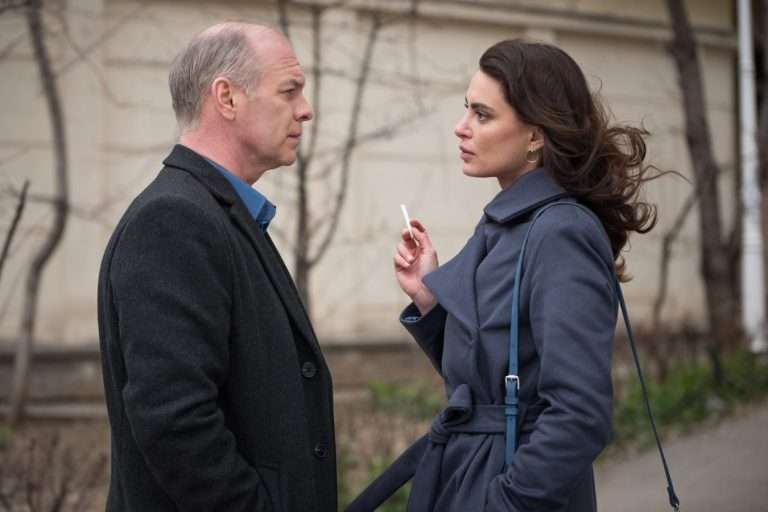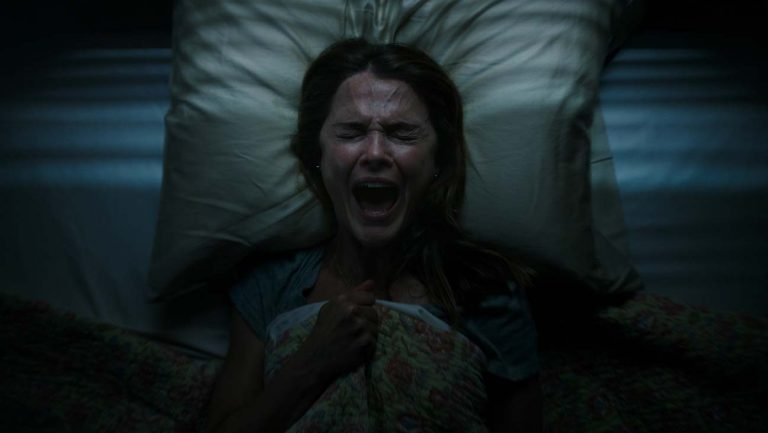Enys Men (2023): It is almost always a sort of challenge issued by a filmmaker to an audience, unwittingly so, when they craft a movie that is simply too obtuse or open to interpretation. Sometimes it becomes a fun exercise in uncovering the indulgence of the filmmaker. Other times, it becomes almost frustrating, especially when the resultant film feels less structured and deals wholly in abstractions and content to leave the film unexplained. Like David Lynch, Mark Jenkin tries to visualize a dream in film format. The result is a maddening, frustrating, and yet compelling film one can’t look away from.
Enys Men (2023) Movie Synopsis & Plot Summary:
This writer might sound in a jocular mood, but the plot of the movie is the least important thing about this movie. Like the director’s previous directorial effort, Bait, this too has the idea of a narrative. Unlike “Bait,” the idea is the bare minimum. On the island of “Enys Men” (Stone Island), a woman (named in the credits as the “Volunteer”) lives out a solitary ritualistic existence.
The island is filled with rocky outgrowths, stone menhirs at the top of the hilly mountainside, and the sea crashing against the rocks. On this solitary island, the volunteer lives. Her purpose is to wake up every morning and visit the six flowers she is apparently given the responsibility to conduct research on. There, she first checks the soil temperature before checking for any outgrowths or any discernible change in the flower. Once that is done, she makes the return trek.
While returning, she stops at a well (which might be an entrance to a tin mine) and drops a rock to gauge the depth of the gorge until she hears the clatter of the rock splashing into the water. After that, the woman returns home and records the observation about the flower in her diary. From the diary, it is discerned that the setting is 1973; it is almost the end of April. After that, she walks out to the back of the vine-covered exterior hut and turns on the generator (with some effort, as fuel is low).
Then she puts the kettle on for tea and has breakfast before her two-way radio crackles open, and the boatman (presumably) informs her that he will be ready to come to her place with supplies. It is established that supplies come to this island every two weeks, and other than that minuscule amount of contact, the woman stays alone. She lies in bed at night by candlelight, reading Edward Goldsmith’s environmental text “A Blueprint for Survival.” This is the closest Jenkin comes to a heavy-handed hint about the ecological theme of the film.
She talks on her radio, where she informs the woman on the other side that she is alone, not lonely; she is running out of petrol, tea, and coffee grounds. However, the movie itself chooses to sometimes break free of the monotony as if to acknowledge the drudgery of the volunteer’s existence. We first see a young girl standing behind her in the dead of the night. We believe that it is the volunteer’s daughter, as she checks up on the sleeping girl before going back to her bed.
However, the next morning, when she warns the girl not to climb up on the roof of the house, the girl repeats it in an almost monotonous voice, as if emoting from a radio. There are also strange occurrences happening. She sometimes sees the face of a man while walking back from the rock outgrowth croppings and crossing the large stone structure, or menhir, that had been erected as a memorial for the miners who had lost their lives after being trapped below the island.
The volunteer also hears the thumping of a hammer on the rock when she tries to hear it through the rocky outgrowths. She also tries to clamber down to the shore and brings out what is essentially a piece of boat wreckage. The wreckage, bearing the name Oven,” is placed on the mantlepiece of the volunteer’s hut. At night, a preacher appears.
As for the island, as the days progress, it seems to come to life on its own. First, we hear an eerie rumbling below the ground, as if the mining train has begun on its own. Then we feel her being pulled towards the well as if by some unseen magnetic force. As time progresses, the visions become clearer and yet more obtuse. The radio frequency converts to the sounds of a baby crying as we see the volunteer walk up to what is presumably a church surrounded by menhirs.
We will see later and can infer that the preacher we witnessed in the dark is providing baptism to a baby. The volunteer further explores as she walks down to the dock, where a boat would presumably be back with supplies. It was the site of an accident where a lifeboat lost all hands in the rescue of the supply boat Govenek. At night, the volunteer hears the children singing, and as she looks out in the darkness, she can almost hear the voices coming from far away.
She asks, “Who is there?” but there isn’t any answer until suddenly she sees a vision, and as the viewer, we too are blindsided by visions of a young woman in the dark, the volunteer walking backward into the house, and suddenly flashes of a haunted face before the screen settles on the rock. The next day, as she resumes her ritual again, she hears from the radio “Approaching,” after which she presumably walks back and washes a dirty yellow raincoat.
Making sense of the visions
The title of the sub-heading itself is an oxymoron, as according to the director, Mark Jenkin, in an interview with Den of Geek, making sense of the film in any narrative structure might cause a viewer to overthink and drive themselves mad. So from that vantage point alone, this writer might just try to make sense of the individual strange occurrences rather than trying to add them up to any coherent whole.
What does the lichen mean?
Lichens appearing on the flower are the first sign of physical change, which almost transforms the drudgery of the volunteer’s character. The growth of the lichen over the flower is followed by the growth of the lichen over the full, long scar over the stomach of the volunteer. Coincidentally, or perhaps not, that same long scar is also seen on the young girl’s stomach as a result of jumping down from the top of the hut and smashing through plate glass.
It proves that time is already slipping on this island, and the volunteer is hallucinating. The idea of lichen being able to jut out of hard surfaces and cracks in walls is almost akin to something supernatural trying to pierce through the veil of reality within its cracks.
Who is the boatman?
The boatman is one of two other human figures the volunteer comes into contact with. The boatman, however, is the one she has a conversation with when she brings her petrol and water. Amidst visions, we see the two of them dancing to music, or we see her having sex with him. But later on, we see the dead body of the boatman with the same yellow jacket floating face down in the sea. In that same vision, we see the body of the boatman being rescued by the volunteer herself, along with members of her rescue team.
Also fascinatingly, the event of the accident takes place on the 1st of May 1973, while the movie begins on the 18th of April 1973. So there is already a sense of cognitive dissonance existing within the character of the volunteer, or even the fact that multiple timelines are colliding on top of each other, perhaps because of the unchanging nature of Enys Men and the island itself. If we are truly trying to make sense of the events, the baby being baptized could also be the daughter of the volunteer. Perhaps the young lady she imagines is an amalgamation of her younger self and her imaginary daughter.
What do the other appearances entail?

We see further appearances, which could be taken as spirits of the history of the island, coming through as apparitions. There are the six Bal-Maidens (coincidentally similar to the number of flowers the volunteer examines), women who were employed at mining sites where they would prepare materials for smelting. The volunteer also witnessed apparitions in the form of children dressed like angels standing in front of her moss- and wine-covered cottage and singing a Welsh folk song.
It could be a symbolic gesture to Mayday, or the 1st of May, which is a far more important day of celebration for the island of Cornwall than the arbitrary holiday celebrated around the rest of the world. Or it could be a pagan ritual of worship or rebirth as the season of spring approaches. She also witnesses the apparitions of the sailors of the lifeboat who lost their lives while trying to rescue the Govenek (the boat).
There is a certain amount of evidence pointing towards the history of Cornwall literally rising out of the ground as apparitions, as in the final moments of her hallucinations, she witnesses the big menhir erected as a memorial for the people lost in the rescue accident suddenly appear in front of her door. While it could be attributed to her losing her spatial sense, the 1977 film Stigma showed how the removal of such a menhir could lead to supernatural occurrences.
The movie “Stigma” is definitely an inspiration from a mood and tonal standpoint. The last of the unexplained visions that she witnesses are the miners with their headlamps looking back at her as she discovers a passage to the mines from her cottage and even witnesses an apparition of a miner walking out of her cottage. Tin mining has always been an integral part of Cornwall’s economy, and this feels like the history of the island itself peeking through and reminding us of its existence.
Enys Men (2023) Movie Ending Explained:
The volunteer’s hallucinations begin to exacerbate to the extent that she tries to shut down the mine shaft with a huge rock, imagining one of the miners looking up at her and smiling. The next vision we see is her cutting the flowers away from the stalk as if to disconnect them from the island because, in her hallucinations, she had been visualizing that her flowers had disappeared.
Because the timelines had been collapsing on each other, it could be entirely possible that she had already been cutting the flowers from the stalk. The movie finally ends with her returning to the hut as per her ritual, standing in front of her hut, before the camera cuts to a supposed future of the house completely covered in moss and vine. The story of “Enys Men” is perhaps literally the story of “the stone island,” and that was how it ended, with a folk song and a menhir.
Enys Men (2023) Movie Themes Analysed:
Why is the volunteer seeing these visions?
Occam’s razor states that in a sea of complicated explanations, the simplest one is the most probable. In this circumstance, the simplest explanation seems to be boredom from the drudgery of her ritualistic experience. Idle minds beget the most outlandish observations and worst-case scenarios imaginable. It is also certain that many visions closely pertaining to her (the boatman or the girl) could very much carry a kernel of truth, traumatic events from her past, both recent and far-reaching. The one time she tries to come back to her present is when she intentionally tries to burn her hand on the gas, effectively grounding her to reality.
What does the film mean?
“Enys Men” feels like Mark Jenkin’s exercise in crafting an eerie horror. Eerie, by definition, focuses on moments of unsettlement or uncanniness. Mark Jenkin’s film can be described as “English eerie,” a very rural form of horror where supernatural elements are exhibited and confronted in relation to the past, both personal and historical. In Jenkin’s work, as well as the work that inspires Jenkin, there is a definite movement to subvert the description of the pastoral English countryside. It is to show the horrifying past, literally buried and burned, and bring it out to the public consciousness through storytelling, either visceral or with unease.
A slow, uneasy dread and unique and harrowing moments are preferred over direct confrontation and bloodletting. However, Enys Men itself feels less like folk horror like “The Wicker Man” and even “Stigma” and more like a Cornish film made by a filmmaker who is trying to make sense of the gorgeous atmosphere, the rugged countryside, and the modernity clashing with its past. It is depicted in a dreamlike fashion, with no inclination to resemble a traditional narrative
Enys Men (2023) Movie Final Thoughts:
Mark Jenkin’s sophomore work is challenging and almost frustratingly gorgeous. It is not interested in making sense of what is being shown on the screen, and it trusts the viewer to be astute enough to understand how time collapses on itself as the minute instabilities of the landscape become part of the narrative and thematic quality of the film. As a result, though, the movie becomes an exercise in patience, a far more experiential form of storytelling than a narrative one. Mary Woodvine, as the sole actor who the audience has to follow, is sublime in her little tics and her stony visage, giving the movie a far more compelling air than the story she is saddled with.
One could enjoy this movie as an unvarnished vision of what Cornwall is, though for someone with little to no knowledge of that countryside, a lack of context only serves to increase that obtuseness. However, Jenkin’s propensity to shoot the film with a 16mm Bolex camera with no synchronous sound produces gorgeous grainy visuals. It then allows him to provide ADR and Foley and create a soundscape that becomes a totally immersive experience.
At its core, “Enys Men” is not about a story or a plot. “Enys Men” is about immersion, about capturing a vibe, and for viewers specifically searching for such an experience, they will have a high dopamine rush. Remember to keep your questions at bay, though, because the movie won’t answer them.










